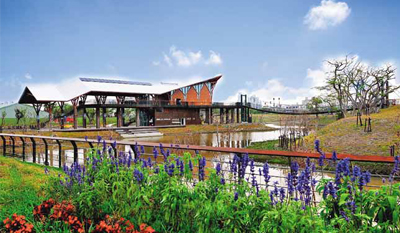| Jhongdou Wetlands Park |
 |
Jhongdou Wetlands Park, along with three proposed park sites in Jhongdou region and two proposed school sites, is designed as a large-scale wetlands park. Listed as one of the major construction projects in 2009, its construction commenced on January 15, 2010, and was completed for opening on April 24 2011. The Park covers an area of 12.6 hectares and can capture about 112 tons of carbons per year. |
| Creating A New Look and Values for Jhongdou The location of the Park was a part of the Jhongdou Industrial Zone during the Japanese colonial period and became a region clustered with plywood factories after Taiwan was liberated from Japan. After the plywood industry moved overseas in the 1980s, factory buildings and the wood storing ditch were left idle, and weeds were allowed to overrun the area. As the area degraded, the landscapes and quality of the city were negatively in�uenced. Jhongdou became a breeding ground for crime and the Dengue fever.The Kaohsiung City government therefore invested 3 billion Taiwan dollars into the land readjustment of Jhongdou, demolished buildings, relocated disadvantaged residents, and established wetland parks. The aim was to change the appearance of the Jhongdou region and solve the environmental problems troubling the neighborhoods for over 4 decades. |
| Nature and Humanity – Coexist in Harmony The design of Jhongdou Wetland Park is based on the principle of reestablishing Kaohsiung City's mangrove forest ecology. The wood storage ditch is expanded into a circular waterway with both ends connected to the Love River. The waterway runs across the Park and takes the advantage of the convergence of the Love River and seawater to restore the mangrove forest ecology and littoral forests. With the nearby 100 year old Jhongdou Tangrong Brick Kiln, Jhongdou Wetlands Park not only conserves natural species and history of industry but also will witness the development of Port of Kaohsiung and Kaohsiung City. |
.jpg) |
| Nature and Humanity – Coexist in Harmony Surrounded by the waterway, the Central Ecological Islet will see the reemergence of several tree species found only in Taiwan. There are recreational and educational facilities such as the visitor service center, lawn activity areas, and outdoor ecological classrooms. There will also be waterfront activities such as canoeing to allow visitors to get closer to nature. |
 |
Creating New Values for the Wetlands There are currently 39 species of birds, 3 species of reptiles, and 9 species of beetles found in the Park. Fiddler crabs, mouthbreeders, and milk�sh are also to be spotted here. There are water birds such as common sandpipers, little ringed plovers, and common moorhens during the daytime; after nightfall, there are �ocks of white herons resting in the Park. It is indeed a rare privilege to see such a diverse ecology at the heart of a city. As one of the 18 wetland ecological networks in Kaohsiung, Jhongdou Wetlands Park connects cultural scenic spots from the Love River to the Port of Kaohsiung. |
| The Kaohsiung City government is building Jhongdou Vision Bridge to link Jhongdou region and the area around Kaohsiung Museum of Fine Arts. The Bridge also connects with the 30-meter parkway to link the southern and northern banks of the Love River. The quality of life and tourism around the area have improved, bringing a synergistic e�ect to regional development and creating new value for the city. |
Data Source:Kaohsiung Jhongdou Wetlands Park, Maintenance Office, Public Works Bureau of Kaohsiung City Government |
|